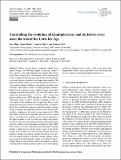Unravelling the evolution of Zmuttgletscher and its debris cover since the end of the Little Ice Age
Date
11/07/2019Metadata
Show full item recordAbstract
Debris-covered glaciers generally exhibit large, gently sloping, slow-flowing tongues. At present, many of these glaciers show high thinning rates despite thick debris cover. Due to the lack of observations, most existing studies have neglected the dynamic interactions between debris cover and glacier evolution over longer time periods. The main aim of this study is to reveal such interactions by reconstructing changes of debris cover, glacier geometry, flow velocities, and surface features of Zmuttgletscher (Switzerland), based on historic maps, satellite images, aerial photographs, and field observations. We show that debris cover extent has increased from ∼13 % to ∼32 % of the total glacier surface since 1859 and that in 2017 the debris is sufficiently thick to reduce ablation compared to bare ice over much of the ablation area. Despite the debris cover, the glacier-wide mass balance of Zmuttgletscher is comparable to that of debris-free glaciers located in similar settings, whereas changes in length and area have been small and delayed by comparison. Increased ice mass input in the 1970s and 1980s resulted in a temporary velocity increase, which led to a local decrease in debris cover extent, a lowering of the upper boundary of the ice-cliff zone, and a strong reduction in ice-cliff area, indicating a dynamic link between flow velocities, debris cover, and surface morphology. Since 2005, the lowermost 1.5 km of the glacier has been quasi-stagnant, despite a slight increase in the surface slope of the glacier tongue. We conclude that the long-term glacier-wide mass balance is mainly governed by climate. The debris cover governs the spatial pattern of elevation change without changing its glacier-wide magnitude, which we explain by the extended ablation area and the enhanced thinning in regions with thin debris further up-glacier and in areas with abundant meltwater channels and ice cliffs. At the same time rising temperatures lead to increasing debris cover and decreasing ice flux, thereby attenuating length and area losses.
Citation
Mölg , N , Bolch , T , Walter , A & Vieli , A 2019 , ' Unravelling the evolution of Zmuttgletscher and its debris cover since the end of the Little Ice Age ' , The Cryosphere , vol. 13 , no. 7 , pp. 1889-1909 . https://doi.org/10.5194/tc-13-1889-2019
Publication
The Cryosphere
Status
Peer reviewed
ISSN
1994-0416Type
Journal article
Description
This research has been supported by the Swiss National Science Foundation “Understanding and quantifying the transient dynamics and evolution of debris-covered glaciers” (grant no. 200021_169775).Collections
Items in the St Andrews Research Repository are protected by copyright, with all rights reserved, unless otherwise indicated.

